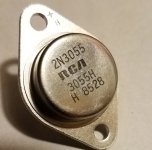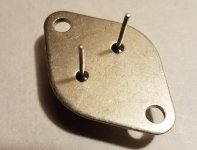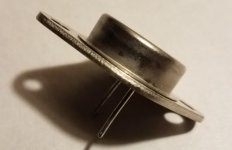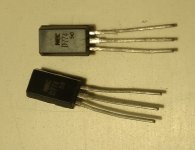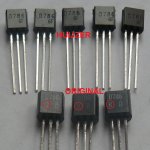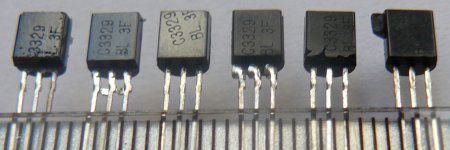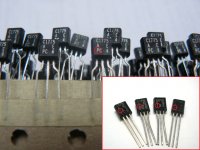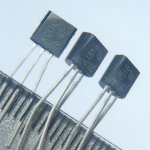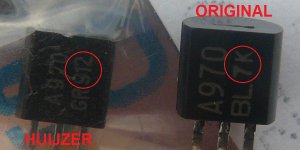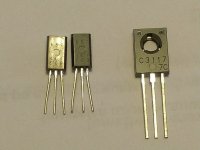You might be best starting a new thread for this over in the solid state forums.
Also:
How to attach images to your posts.
Also:
How to attach images to your posts.
What do you think of this? It was soured in the USA as nos 3055H. Also wondering what the Ft should be for these devices. I have read conflicting info, some say later RCA homotaxial have Ft at 2+MHz and others say 800 KHz
Thanks,
Marty
Thanks,
Marty
Attachments
Hi
It is true. Some technical sheets show 800 kHz and in other 1.5 MHz.
I attached two data sheets in the RCA catalog on page 264.
https://www.silicon-ark.co.uk/datasheets/2n3055-datasheet-rca.pdf
http://mirror.thelifeofkenneth.com/...RcaPowerTransistorApplicationsManual_text.pdf
It is true. Some technical sheets show 800 kHz and in other 1.5 MHz.
I attached two data sheets in the RCA catalog on page 264.
https://www.silicon-ark.co.uk/datasheets/2n3055-datasheet-rca.pdf
http://mirror.thelifeofkenneth.com/...RcaPowerTransistorApplicationsManual_text.pdf
Last edited:
Hi Marty,
A real 2N3055 has an Ft of 800 KHz. It was designed for power supply use as the pass transistor that was commonly mounted on a heat sink away from the PCB Normal power transistors can oscillate under those conditions. Some of the really early ones had an Ft of 19 KHz. I got that figure from some really early documents from Lambda (they defined the transistor for use in their power supply products). Motorola may have designed those original parts.
When looking at the specifications for a transistor, always go with the collector - emitter breakdown voltage. The collector - base junction rating is optimistic and you don't generally use transistors in this way.
-Chris
A real 2N3055 has an Ft of 800 KHz. It was designed for power supply use as the pass transistor that was commonly mounted on a heat sink away from the PCB Normal power transistors can oscillate under those conditions. Some of the really early ones had an Ft of 19 KHz. I got that figure from some really early documents from Lambda (they defined the transistor for use in their power supply products). Motorola may have designed those original parts.
When looking at the specifications for a transistor, always go with the collector - emitter breakdown voltage. The collector - base junction rating is optimistic and you don't generally use transistors in this way.
-Chris
Thanks for the info guys, I was looking to buy something slower than the current production versions. If they are real they will at least make for some tough pass transistors.
The “H” version is supposed to be the slow hometaxial version. For a while RCA was making both types, with the non H basically equivalent to the Motorola. But I dind’t think they still making hometaxials in 1985 - I thought they stopped when the 2N6259 disappeared in about 82. Maybe they had Emmit’s flux capacitor. Or maybe they were making a tougher version (but still epitaxial) and calling it the H. Motorola/ON did make a tougher 2N3055A for a while, and they never did have the RCA process.
This isn’t about spoofing - but rather a what is it. There are so many different things that are called a “2N3055” that it’s difficult to tell what you’ve really got without further testing or inspection.
Almost any modern NPN epi-base or triple diffused transistor die at least 2 mm on a side and mounted on a heat spreader will pass the generic spec for a 2N3055. None of the parameters are tightly spec’ed and the required SOA is pretty easy by today’s standards. A real one from ON would be tougher and have margin to spec. A real RCA hoemetaxial would be tougher still.
Almost any modern NPN epi-base or triple diffused transistor die at least 2 mm on a side and mounted on a heat spreader will pass the generic spec for a 2N3055. None of the parameters are tightly spec’ed and the required SOA is pretty easy by today’s standards. A real one from ON would be tougher and have margin to spec. A real RCA hoemetaxial would be tougher still.
Hi David,
-Chris
Heck, they spoof 2N3904 as well. Why? Maybe it's in their nature.Why would anyone spoof a 3055.
-Chris
Nickel is also magnetic.The apology for my english is not good.
There is a problem that confuses me. Some transistors draw magnets.
is this normal ? probably have iron instead of copper.It looks in the picture.
Hi grunf,
Tough call. They are clearly not real if NEC only used the case style in the data sheet. They do look suspiciously like new leads may have been attached.
Normally, the remarks I have seen have lower beta, ~200 or lower. So to measure a high beta suggests they might be real, or at least from a stock that has more desirable characteristics.
-Chris
Tough call. They are clearly not real if NEC only used the case style in the data sheet. They do look suspiciously like new leads may have been attached.
Normally, the remarks I have seen have lower beta, ~200 or lower. So to measure a high beta suggests they might be real, or at least from a stock that has more desirable characteristics.
-Chris
Well, fool me once, etc. 🙁 The pictures [below] speak for themselves... Avoid Huijzer at all cost!Huijzer have a lot of interesting 2Sx transistors in stock, but now I'm hesitant to place another order with them...
Seems I'll have to follow your example, as the vendor stopped communicating with me when I told them I want to return these.What do I do with the fakes? I use a 4 pound hand sledge hammer that does a fine job of distressing the cases. It's not worth having fakes turn up unexpectedly, or having another hobbyist "score them" from my garbage. I assure you, mine are not useable if they are fakes. It is very important that you destroy fakes. Even if you pay a lot for them (I know it hurts, but not as much as having to troubleshoot non-working projects because of a part you knew was a bad one).
Attachments
Seeing those group shots tells me that they are for sure fakes. Sorry, I know that isn't the news you wanted to hear.
-Chris
-Chris
Doesn't seem like they can get the print in the right spot. Never seen re-leaded parts before. Wonder if they are pulls.
No worries - I know they're fakes, but I'd better explain my reasoning:Seeing those group shots tells me that they are for sure fakes. Sorry, I know that isn't the news you wanted to hear.
-Chris
On top of the obviously different font types:
- A970: I've seen a lot of various genuine Toshiba transistors over the years, but I've never seen one that would use a 3-digit date code
- A1316 & C3329: the former sanded to oblivion, the latter... I just can't find words to express how horribly poor quality imitations they are

- C1775: AFAIK, the 3-letter Hitachi date codes always start with a digit, representing the year [as you can see in the smaller photo of genuine parts from different production years in the corner]
- D786: the hFE rank is supposed to be printed on the case
I didn't even bother to test these electrically / compare against data sheets...
Hi petoluk,
I was thinking the same thing. I especially liked the ones filed into a wedge shape!
Try to enjoy the destruction of these. A fire might be a good way to a mass extinction for those non-conforming parts. You can also experiment. A very short time in a microwave really messes up electronic components and really does a number on stuffed circuit boards. Keep the cooking time short, Maybe even include a cup of water to avoid damaging the nuker. 🙂 Remember, this experiment is done at your own risk.
-Chris
I was thinking the same thing. I especially liked the ones filed into a wedge shape!
Try to enjoy the destruction of these. A fire might be a good way to a mass extinction for those non-conforming parts. You can also experiment. A very short time in a microwave really messes up electronic components and really does a number on stuffed circuit boards. Keep the cooking time short, Maybe even include a cup of water to avoid damaging the nuker. 🙂 Remember, this experiment is done at your own risk.
-Chris
- Home
- Design & Build
- Parts
- My Transistors, original or copy?
